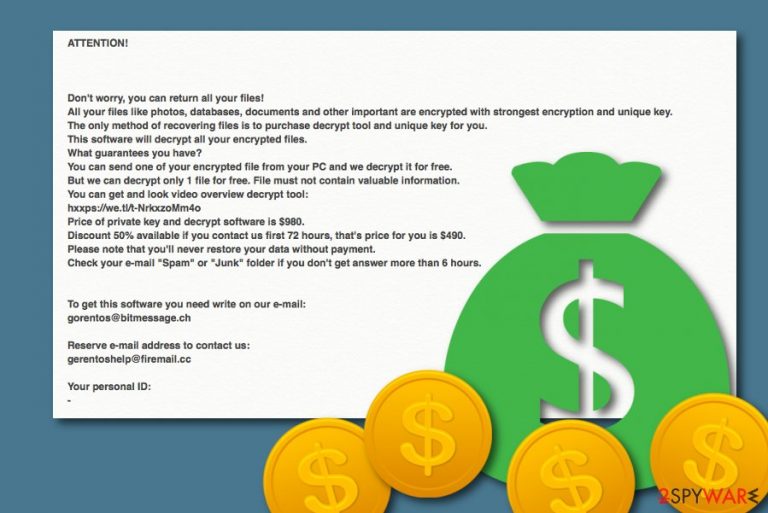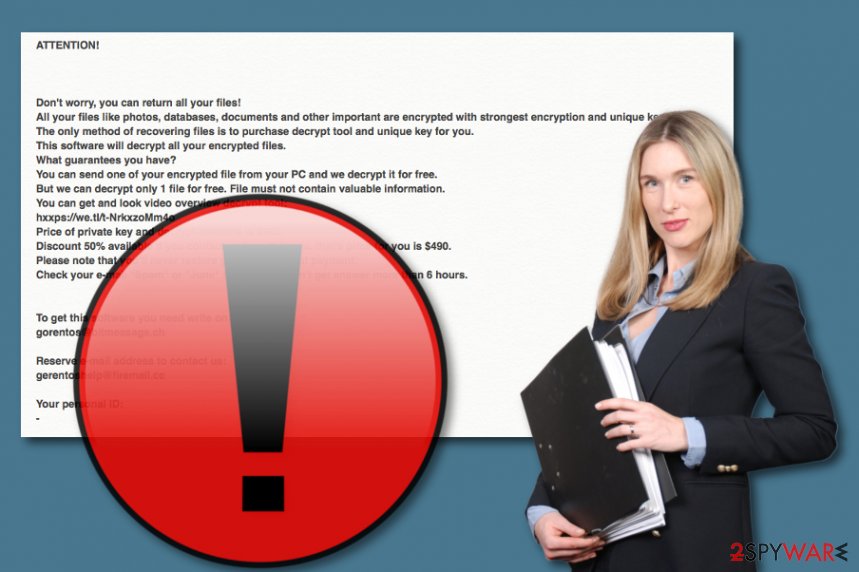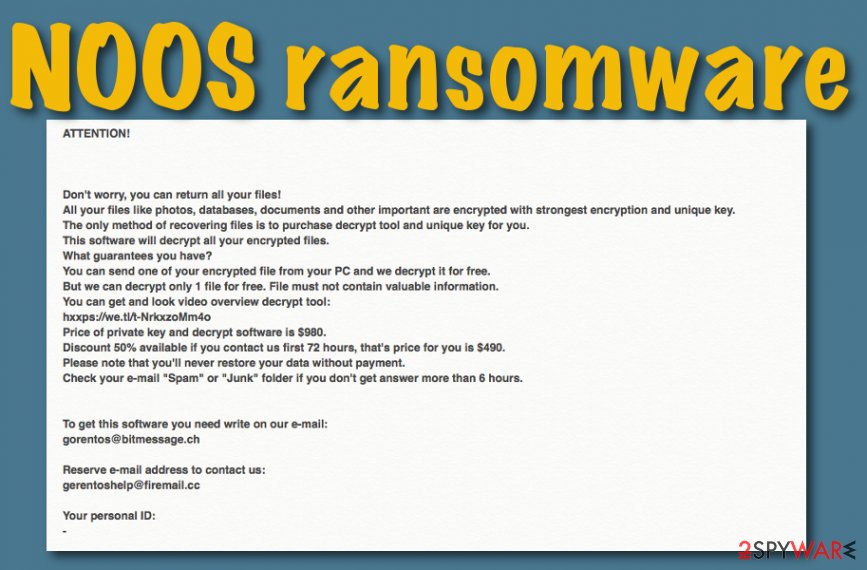NOOS ransomware (Virus Removal Guide) - Improved Instructions
NOOS virus Removal Guide
What is NOOS ransomware?
NOOS ransomware – the 169th Djvu family member that uses private or public keys to disable proper file access

NOOS ransomware is the latest 169th variant of the Djvu category. This time the .noos appendix is included to each file name after locking the component by employing public or private (AES/RSA) encryption tools. Of course, NOOS virus shares the same _readme.txt note as other siblings to express ransom demands which vary between $490-$980 in BTC cryptocurrency. The first price is demanded if the payment comes between 72 hours and if the victim is late, he/she needs to pay a double amount. In addition, the users are allowed to send one file without valuable data included to cyber crooks via gorentos@bitmessage.ch, gorentoshelp@firemail.cc, or @datarestore telegram if they want to receive proof of the decryption key's existence.
| Name | NOOS ransomware |
|---|---|
| Type | Ransomware virus/file-encrypting malware |
| Family | This notorious cyber threat belongs to the Djvu and STOP ransomware families |
| Version number | Since Djvu ransomware creators have been releasing new versions almost daily, NOOS virus appears to be the 169th variant |
| Appendix | Once the malware appears on your computer, do not be surprised to see your files locked and the .noos appendix added to each document name |
| Cipher | Criminals supposedly use encryption keys such as AES or RSA to lock up all data that is found on your computer |
| Ransom note | The typical _readme.txt message is also used by this ransomware virus and placed in each folder that includes locked data |
| Payment conditions | Crooks urge for $490 in BTC if the ransom price is transferred in 72 hours and threaten to double the price if the victims pay the money in a longer time period |
| Spreading | Ransom-demanding malware might be distributed via RDP TCP port 3389, fake FedEx/DHL shipping messages, or p2p networks such as The Pirate Bay |
| Identification | Use antimalware such as FortectIntego to locate all malware-laden strains on your Windows computer system |
NOOS ransomware begins its boot-up process by carrying out different commands. The malware launches PowerShell to eliminate Shadow Volume Copies of encrypted data, prevents Windows Defender from running antivirus protection, stops the Background Intelligent Transfer Service,[1] and corrupts Windows hosts file to disable user access to security-related forums and websites where they might find a solution for NOOS ransomware removal and data recovery.
NOOS ransomware is not a threat to mess with as it might also cause secret infiltration of other malware forms. According to research, STOP ransomware variants carry an additional virus named AZORult. This is a trojan that might be distributed together with each Djvu/STOP form. Once installed, the Trojan virus might steal your passwords, access private data, swindle money from your bank account, relate to severe system and software damage.
The best decision for you here is to remove NOOS ransomware as fast as possible. This process should be taken seriously in order to delete all malicious strains that have been planted on your computer during the malware attack. First, use software such as FortectIntego to discover all the malware-laden objects and then employ automatical cleaning and repair software that is capable of eliminating the ransomware infection from your Windows operating system.

If you are wondering what type of changes and processes signify about the NOOS ransomware appearance, there might be several of them. One is that your file names are changed with the .noos extension added to them. Also, you might see questionable processes running in the Windows Registry and Task Manager that allow the malware to boot up automatically and perform encryption tasks. Besides, malicious content has a chance to be spotted in these locations:
- %AppData%;
- %Temp%;
- %Roaming%;
- %Local%;
- %LocalLow%%.
Cybercriminals who promote NOOS ransomware urge for a hug ransom price. Our suggestion would be to avoid paying it as there is a risk of receiving no decryption software at all. Hackers are known for scamming their victims as they are only self-orientated in these types of situations. In addition, do not be threatened by claims in the ransom message that your files will be lost forever if you do not contact and pay the cyber crooks immediately:
ATTENTION!
Don't worry, you can return all your files!
All your files like photos, databases, documents and other important are encrypted with strongest encryption and unique key.
The only method of recovering files is to purchase decrypt tool and unique key for you.
This software will decrypt all your encrypted files.
What guarantees you have?
You can send one of your encrypted file from your PC and we decrypt it for free.
But we can decrypt only 1 file for free. File must not contain valuable information.
You can get and look video overview decrypt tool:
hxxps://we.tl/t-NrkxzoMm4o
Price of private key and decrypt software is $980.
Discount 50% available if you contact us first 72 hours, that's price for you is $490.
Please note that you'll never restore your data without payment.
Check your e-mail “Spam” or “Junk” folder if you don't get answer more than 6 hours.To get this software you need write on our e-mail:
gorentos@bitmessage.chReserve e-mail address to contact us:
gerentoshelp@firemail.ccYour personal ID:
–
After you uninstall NOOS ransomware from your Windows computer, you can start thinking about file recovery possibilities. Even though cybersecurity experts are currently working on the official decryptor and will release a report once the software is generated, you can take a look at the end of the article where we have provided three different data restoring methods. Pick the one that should be able to work under all conditions.
Continuously, DrWeb experts have also released a solution for those who got attacked by a Djvu malware form such as NOOS ransomware. They offer to try a decryption tool for free and if it appears to be successful for locked files, the user is advised to purchase the Rescue Pack software package for $150. Here you will get data decryption software and antivirus protections for an entire 2 years of time period.

Distribution possibilities that are used by ransomware developers
Experts from LosVirus.es[2] state that ransomware developers think of different techniques on how to bring their beloved viruses to the surface and plant them on random computer systems. Most commonly, hackers fake to be from FedEx, DHL, or similar order shipping agencies and drop order confirmation messages to victims' email addresses.
Here you might be provided with a hyperlink that is “necessary” to confirm a shipment or with a bogus Word, Excel, or similar attachment that supposedly includes order-related information. These types of components need to be avoided and definitely not opened before scanning each one with reputable antimalware software.
In addition, RDP[3] is also known to be a way how ransomware reaches Windows computers. The TCP port 3389 is recognized as a vulnerable one which cybercriminals hack and use to brutally enter machines. Last but not least, p2p networks[4] such as The Pirate Bay also might include infectious hyperlinks with ransomware-related payload.
Necessary steps towards full computer protection against ransomware viruses
The combination of automatical and manual protection is the best way to ensure that the risk of cyber attacks decreases slightly. First of all, choose a reliable security product that will take care of your computer system and prevent various malware forms, including ransomware, from accessing your machine and its software.
Continuously, do not visit sources that force any security concerns. You should keep a distance from secondary-downloading networks, online-dating, adult-themed pages that include pornography, gambling, etc. Besides, if your AV tool marks the website that you are looking forward to visiting as unsafe, you should definitely not proceed further.
For data safety, you should always store backups of important data on at least a couple of different servers/devices. A good decision would be to purchase a USB flash drive and keep copies of valuable files there. However, remember to unplug it after usage as if you keep it connected to the computer all the time, your data might still get encrypted after a ransomware attack.
NOOS ransomware removal (automatical only)
NOOS ransomware removal is not a process to play with so you should no try to eliminate the cyber threat on your own. Instead of risking to make damaging mistakes, you should employ reliable tools to scan the system for infected locations. You can choose to install a program such as FortectIntego, SpyHunter 5Combo Cleaner, or Malwarebytes.
In addition, before you start to remove NOOS ransomware, you should boot your computer in Safe Mode with Networking or System Restore just to ensure that all malicious processes have been disabled on our Windows operating system and that the malware will not boot up again automatically.
When NOOS ransomware is gone, you can try the below-provided data recovery solutions. Also, DrWeb cybersecurity firm has released a Rescue Pack for $150 that includes data recovery software and antimalware protection for 2 years which you also might find helpful.
Getting rid of NOOS virus. Follow these steps
Manual removal using Safe Mode
Boot your Windows machine by using Safe Mode with Networking to disable malicious processes
Important! →
Manual removal guide might be too complicated for regular computer users. It requires advanced IT knowledge to be performed correctly (if vital system files are removed or damaged, it might result in full Windows compromise), and it also might take hours to complete. Therefore, we highly advise using the automatic method provided above instead.
Step 1. Access Safe Mode with Networking
Manual malware removal should be best performed in the Safe Mode environment.
Windows 7 / Vista / XP
- Click Start > Shutdown > Restart > OK.
- When your computer becomes active, start pressing F8 button (if that does not work, try F2, F12, Del, etc. – it all depends on your motherboard model) multiple times until you see the Advanced Boot Options window.
- Select Safe Mode with Networking from the list.

Windows 10 / Windows 8
- Right-click on Start button and select Settings.

- Scroll down to pick Update & Security.

- On the left side of the window, pick Recovery.
- Now scroll down to find Advanced Startup section.
- Click Restart now.

- Select Troubleshoot.

- Go to Advanced options.

- Select Startup Settings.

- Press Restart.
- Now press 5 or click 5) Enable Safe Mode with Networking.

Step 2. Shut down suspicious processes
Windows Task Manager is a useful tool that shows all the processes running in the background. If malware is running a process, you need to shut it down:
- Press Ctrl + Shift + Esc on your keyboard to open Windows Task Manager.
- Click on More details.

- Scroll down to Background processes section, and look for anything suspicious.
- Right-click and select Open file location.

- Go back to the process, right-click and pick End Task.

- Delete the contents of the malicious folder.
Step 3. Check program Startup
- Press Ctrl + Shift + Esc on your keyboard to open Windows Task Manager.
- Go to Startup tab.
- Right-click on the suspicious program and pick Disable.

Step 4. Delete virus files
Malware-related files can be found in various places within your computer. Here are instructions that could help you find them:
- Type in Disk Cleanup in Windows search and press Enter.

- Select the drive you want to clean (C: is your main drive by default and is likely to be the one that has malicious files in).
- Scroll through the Files to delete list and select the following:
Temporary Internet Files
Downloads
Recycle Bin
Temporary files - Pick Clean up system files.

- You can also look for other malicious files hidden in the following folders (type these entries in Windows Search and press Enter):
%AppData%
%LocalAppData%
%ProgramData%
%WinDir%
After you are finished, reboot the PC in normal mode.
Remove NOOS using System Restore
Use these steps to activate System Restore and prevent all malicious activities from continuation
-
Step 1: Reboot your computer to Safe Mode with Command Prompt
Windows 7 / Vista / XP- Click Start → Shutdown → Restart → OK.
- When your computer becomes active, start pressing F8 multiple times until you see the Advanced Boot Options window.
-
Select Command Prompt from the list

Windows 10 / Windows 8- Press the Power button at the Windows login screen. Now press and hold Shift, which is on your keyboard, and click Restart..
- Now select Troubleshoot → Advanced options → Startup Settings and finally press Restart.
-
Once your computer becomes active, select Enable Safe Mode with Command Prompt in Startup Settings window.

-
Step 2: Restore your system files and settings
-
Once the Command Prompt window shows up, enter cd restore and click Enter.

-
Now type rstrui.exe and press Enter again..

-
When a new window shows up, click Next and select your restore point that is prior the infiltration of NOOS. After doing that, click Next.


-
Now click Yes to start system restore.

-
Once the Command Prompt window shows up, enter cd restore and click Enter.
Bonus: Recover your data
Guide which is presented above is supposed to help you remove NOOS from your computer. To recover your encrypted files, we recommend using a detailed guide prepared by 2-spyware.com security experts.If your files are encrypted by NOOS, you can use several methods to restore them:
Use Data Recovery Pro to bring some individual files back
If you are likely to restore some locked or corrupted data, try using this software
- Download Data Recovery Pro;
- Follow the steps of Data Recovery Setup and install the program on your computer;
- Launch it and scan your computer for files encrypted by NOOS ransomware;
- Restore them.
Employ Windows Previous Versions feature for data restore tasks
If you have enabled System Restore at first, you can give this equipment a try
- Find an encrypted file you need to restore and right-click on it;
- Select “Properties” and go to “Previous versions” tab;
- Here, check each of available copies of the file in “Folder versions”. You should select the version you want to recover and click “Restore”.
Activate Shadow Explorer for data recovery
However, this tool will not operate if the ransomware virus has already eliminated Shadow Volume Copies of locked items
- Download Shadow Explorer (http://shadowexplorer.com/);
- Follow a Shadow Explorer Setup Wizard and install this application on your computer;
- Launch the program and go through the drop down menu on the top left corner to select the disk of your encrypted data. Check what folders are there;
- Right-click on the folder you want to restore and select “Export”. You can also select where you want it to be stored.
Currently, there is no official decryptor available for .noos files
Finally, you should always think about the protection of crypto-ransomwares. In order to protect your computer from NOOS and other ransomwares, use a reputable anti-spyware, such as FortectIntego, SpyHunter 5Combo Cleaner or Malwarebytes
How to prevent from getting ransomware
Protect your privacy – employ a VPN
There are several ways how to make your online time more private – you can access an incognito tab. However, there is no secret that even in this mode, you are tracked for advertising purposes. There is a way to add an extra layer of protection and create a completely anonymous web browsing practice with the help of Private Internet Access VPN. This software reroutes traffic through different servers, thus leaving your IP address and geolocation in disguise. Besides, it is based on a strict no-log policy, meaning that no data will be recorded, leaked, and available for both first and third parties. The combination of a secure web browser and Private Internet Access VPN will let you browse the Internet without a feeling of being spied or targeted by criminals.
No backups? No problem. Use a data recovery tool
If you wonder how data loss can occur, you should not look any further for answers – human errors, malware attacks, hardware failures, power cuts, natural disasters, or even simple negligence. In some cases, lost files are extremely important, and many straight out panic when such an unfortunate course of events happen. Due to this, you should always ensure that you prepare proper data backups on a regular basis.
If you were caught by surprise and did not have any backups to restore your files from, not everything is lost. Data Recovery Pro is one of the leading file recovery solutions you can find on the market – it is likely to restore even lost emails or data located on an external device.
- ^ Background Intelligent Transfer Service. Wikipedia. The free encyclopedia.
- ^ LosVirus.es. LosVirus. Cybersecurity and spyware news.
- ^ Margaret Rouse. Remote desktop protocol (RDP). Search Enterprise Desktop. Tech Target.
- ^ P2P. Tech terms. Definitions.







